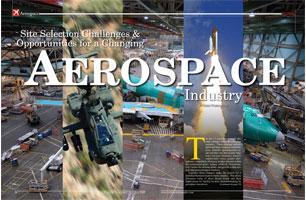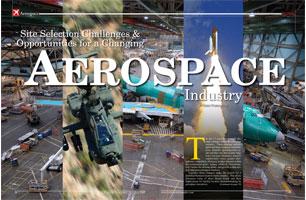
 The last fifteen years have brought dramatic changes within the aerospace industry. These changes include rapid and large company consolidations, dramatic spending/sales cycles (mostly cuts, but recently large year-over-year increases), massive employment losses, greater international competition, changing product demand within the commercial sector, halting efforts at “transformation” within the defense sector, and growth within several emergent aerospace markets.
The last fifteen years have brought dramatic changes within the aerospace industry. These changes include rapid and large company consolidations, dramatic spending/sales cycles (mostly cuts, but recently large year-over-year increases), massive employment losses, greater international competition, changing product demand within the commercial sector, halting efforts at “transformation” within the defense sector, and growth within several emergent aerospace markets.
Together these changes make the search for a preferred business location more complex. This article discusses some of these broad trends and their implications for facility location decision-making by aerospace executives.
SITE SELECTION & REAL ESTATE STRATEGY
The site selection process for new or consolidating facilities should begin with a strategic planning phase. This phase establishes key business goals and operational objectives; aligns the proposed real estate project with the firm’s vision and mission; and includes a detailed “needs assessment” on all business and facility requirements.
Once specific location and facility parameters are established, the next phase focuses on the location search and selection of a preferred site or facility. This involves identifying broad geographic target areas, narrowing the search according to site- and building-specific criteria, and evaluating each state and local alternative. The site selection due diligence focuses on issues such as:
Labor availability and wage levels
Other business costs, including taxes, utilities, land prices
Supply chain considerations – proximity and cost of accessing markets, suppliers, and customers
Regulatory and environmental constraints
Regional economics
Quality of life, especially for valued transferees
Real estate suitability (cost, timing, quality, and flexibility)
Business incentives.
A rigorous site selection process can effectively identify business locations and real estate opportunities that reduce operating costs and mitigate business risk. There are, however, a number of issues that require special attention for aerospace decision-makers.
The Changing Geography of Aerospace
Spending and employment trends in the aerospace industry are a study in continuity amidst change. Gains and losses in industry sales and employment over the last 15 years vary by business segment, and have differentially affected states and cities across the United States.
According to the American Aerospace Industries Association (AAIA), total aerospace sales fell from $123.5 billion in 1990 to $89.7 billion in 1994, a 27% decline in just five years. Commercial and defense sector spending today is still only just approaching the levels seen in 1990 (in constant dollars).
During this same period, the aerospace industry experienced unprecedented consolidation activity. The final years of the 1990s saw record-breaking mergers in terms of overall value ($49 billion in acquisitions in 1997) and number of deals (573 firms purchased in 1998).
The combined effect of spending cuts and consolidations has been profound negative impacts on employment in the industry. Between 1991 and 2005, U.S. aerospace employment fell by more than 400,000 jobs (estimates vary by source), a roughly 40% decline from a base of over 1 million employees in 1991.
With job cuts and facility closures resulting from company mergers and program changes, the changing geography of the industry can be described with three broad trends:
1. Massive job losses in cities and states with historically high levels of industry employment. These locations remain the largest aerospace centers despite the job losses (e.g. California, Washington, Texas, Kansas);
2. Significant investment and job gains in historically small aerospace markets, with high percentage growth from a relatively low employment base (e.g. Arizona, Georgia, Alabama); and
3. A mixed bag of gains but mostly even greater losses within mid-tier markets, with some states and cities “winning” and most others “losing” depending upon whether or not the key local aerospace employer has lost a program or been merged with a larger acquiring firm, or if that location’s industry sub-specialization has been de-funded or lost its competitive edge (e.g. New York).
We can use several states to illustrate these trends.
Since 1990, California has lost roughly 176,000 aerospace jobs and lost 36% of its national share of “Aerospace Vehicle and Defense” business. Despite the massive losses, California remains the largest aerospace hub in the nation. Connecticut lost more than 15,000 aerospace jobs over the same 15-year period, but managed to retain its national share of employment in the “Aerospace Engines” manufacturing segment. Washington, Kansas and Texas have meanwhile lost over 100,000 aerospace job losses between them, yet they have grown their overall share of national aerospace employment. It appears that company consolidations have produced some geographic concentration, as well.
In other states where aerospace has not been as dominant historically, jobs cuts have pushed the industry to nearly the point of extinction. There are perhaps a dozen states that fall into this category, including New York which, while having gained 600 jobs in the “Aerospace Engines” sector, has lost more than 17,000 jobs in other aerospace segments, leaving it with less than 2% of national industry share despite providing 6.25% of national employment.
Despite the relative and absolute losses described, there have been some winners in the aerospace industry. A handful of states and cities have grown not only their overall employment levels but also their national market share within the industry. Arizona, Georgia, and Alabama are the primary examples, each having experienced job growth into the thousands over the last 15 years. While these states can claim genuine success for emerging as more important locations within the industry, it is important to note that these gains are small relative to longer-term downturn in the industry, and smaller still in relation to the overall size of the industry.
So how does the aerospace executive navigate the changing landscape of the aerospace industry? No matter what segment of the aerospace market a company operates within, it is important to be cognizant of the forces of both continuity and change. Several of these are elaborated upon below.
Labor Markets & Personnel
Finding the right employees at the right compensation levels is one of the most important and challenging tasks in locating an aerospace facility. This is true for both the civil and defense sectors. Aerospace employees typically require advanced knowledge and skill sets, earn higher-than-average wages, and in certain markets (e.g. Northern Virginia) are in very high demand. The latest data from the Bureau of Labor Statistics show that aerospace manufacturing employees comprise only 3% of the manufacturing workforce nationally, and command an average wage that is 49% above average.
So where are these employees located? The majority of aerospace employees are clustered in the traditional aviation and defense markets of Los Angeles, Puget Sound (Greater Seattle), and Dallas. These three metropolitan areas account for approximately 60% of U.S. aerospace employment, although the aerospace job losses in these major markets have been significant over the last 15 years.
This leaves employers wondering: Do you enter a market where you know there is a large employment base, even if the best and brightest may be already working for the competition? Can you plan on prior job losses providing a ready and available recruitment pool? Or should companies try to find alternative locations, perhaps where labor, real estate, and other business costs are more affordable?
Two location alternatives are worth consideration.
The first option is communities with colleges that offer specialized aerospace programs. According to gradschools.com there are over 90 university or college campuses in the United States offering post-graduate programs in aerospace and aeronautical engineering. These schools are distributed throughout the country and represent an opportunity not only for recruitment, but also joint R&D initiatives and pre-employment training.
The second option is communities with decommissioned military bases or installations that are planned for realignment. The latest Base Realignment and Closure plan (BRAC 2005) identifies 22 major installations to be closed, and many more facilities that will be realigned through downsizing. For aerospace employers, the closures result in large numbers of military and civilian personnel becoming available for new local employment opportunities, or for relocation to other communities.
Labor market questions always require close scrutiny, and sometimes some creative approaches.
Connectivity: Customers, Suppliers, and Competitors
All business location strategies must consider the fundamental spatial relationships between customers, suppliers, and competitors. This is true for an ice cream shop, a retail bank, or a manufacturer. However, the inter-firm and customer dynamics of the aerospace industry magnify the importance of business location decisions.
Large contracts are increasingly won not by lone contractors but by teams of suppliers collaborating to design, build, test, and deploy complex equipment and systems. Knowing how and where a prime contractor will manage a long-term program, and how and where other sub-contractors will deliver their individual project commitments, can influence a location decision. The question to be answered is whether to locate across the street, across the city, or perhaps across the country if this will satisfy both one-off project needs and longer-term business plans.
A site selection decision in aerospace requires foresight because yesterday’s competitor may be today’s customer, and today’s customer may be tomorrow’s supplier. This is especially true as the industry rapidly consolidates and more spending and sales get concentrated in the hands of fewer firms. Proximity has its advantages but also its pitfalls.
Increased outsourcing of component subassembly requires aerospace companies to be more cognizant of not only where their suppliers are located, but how product is to be transported. How will a location choice affect the speed and reliability with which sub-assembled components can be received from suppliers, and delivered to end-user customers? A thorough site selection “needs analysis” will address all of the modes of transportation required: air and truck for smaller components; rail and water for larger assemblies. Considering that the aerospace industry is one of America’s few manufacturing sectors with a robust surplus in its balance of trade, and that aerospace product imports are approaching their highest levels on record, supply chain issues are more important than ever.
Real Estate & Facility Issues
For aerospace companies, real estate & facility tactics cannot be separated from broader location decisions, which themselves are outcomes of larger business strategy. The three are inter-twined.
The number one real estate and facility issue today for the large contractors is “portfolio optimization”, that is, improving facility space utilization and reducing overall spending on real estate through a combination of closures, relocations, and space use intensification efforts. This is essential for companies that have grown quickly through acquisition. Lockheed Martin, for example, the largest of all defense contractors, was created from what were 18 separate companies just 15 years ago. Raytheon, though smaller, is a “top 5” contractor built from six separate companies. For these and many other firms, there is an ongoing challenge to consolidate new acquisitions and determine the best place (geographic location and facility site) for the acquired business to occur.
For both large and small aerospace firms, the choice of location and facility must take into consideration other factors, including:
Will political influence over project funding affect a new location decision, or constrain its potential move at a later date?
How will security issues, including the capital cost and certification of “SCIF space” (Sensitive Compartmented Information Facilities), affect a company’s ability to enter into, and exit from, a facility lease?
What are the advantages and disadvantages of “co-locating” at a customer’s facility? Does it matter if the customer is a private company or a government agency?
Many times, a location and facility decision is “program specific”, influenced by a single, large customer contract. This may strongly influence the location decision-making process toward establishing close physical proximity, perhaps by locating operations in the same business park or nearby business district. It is critical to ask, however, if this choice will enable or constrain the development of other business opportunities, the goal being to maximize the contribution of each facility to your long-term business goals.
Incentives that Deliver Value
Aerospace investment is coveted by state and local economic developers. Aerospace is associated with high wages, heavy intellectual capital, public-private-educational collaboration, and, for some business segments, a strong multiplier and “cluster” effect that helps to build strong regional economies.
Today, a number of states and cities are promoting aerospace initiatives of some kind. For example, Wisconsin has approved $100-million to launch a space program. New Mexico, meanwhile, is lobbying to be the base of Richard Branson’s Virgin Galactic tourists-in-space project. However, while many jurisdictions have targeted aerospace companies as “business attraction targets”, a review of U.S. states show few incentives programs that are specific to the aerospace industry (aside from BRAC-related programs). Most so-called aerospace initiatives are little more than marketing campaigns. Few jurisdictions have followed Texas’ example, which created an Office of Aerospace & Aviation and published a five-year “Strategic Goals” plan.
The challenge for business and location consultants is to distinguish between economic development marketing and economic development policies, only the latter of which can deliver real value to companies prepared to make an investment.
For aerospace companies, the incentives procurement and management process can be promising but also has pitfalls. Simply stated, the value of a government incentives package is typically based on the value of private capital invested and the quantity and quality of jobs created. On the surface, many aerospace companies appear to be good candidates for incentives because the capital expenditure required to “stand up” a new facility is generally large, and the wage and skill levels for aerospace workers both tend to be high. At the same time, however, aerospace investment is often tied to short-term contracts or “soft money” programs that can be cut. And coveted aerospace jobs are frequently contract positions, not full-time hires, which also changes the incentives calculus.
The apparent strengths of aerospace investment can thus be illusory, creating risk for the company and, consequently, its government “partners” who seek to co-invest and stimulate local economic development. It is critical, therefore, that all aerospace site selection and real estate strategies have realistic plans for procuring incentives and managing the downside risk should a program or contract be terminated.
MAKING LOCATION DECISIONS THAT FLY
The aerospace industry is in flux, and the geography of aerospace business is changing along with it. Consolidations, base realignments, defense program changes, and gyrations in the commercial aviation sector are buffeting even those aerospace companies that are experiencing great success currently.
A disciplined, systematic site selection process for new and consolidating aerospace facilities can generate genuine benefits. These include lower operating costs, reduced business risk, and real estate solutions that not only satisfy but advance larger corporate objectives so your business can really take off.

